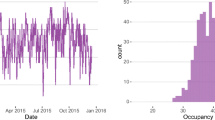Abstract
A stochastic version of the Harrison—Millard multistage model of the flow of patients through a hospital division is developed in order to model correctly not only the average but also the variability in occupancy levels, since it is the variability that makes planning difficult and high percent occupancy levels increase the risk of frequent overflows. The model is fit to one year of data from the medical division of an acute care hospital in Adelaide, Australia. Admissions can be modeled as a Poisson process with rates varying by day of the week and by season. Methods are developed to use the entire annual occupancy profile to estimate transition rate parameters when admission rates are not constant and to estimate rate parameters that vary by day of the week and by season, which are necessary for the model variability to be as large as in the data. The final model matches well the mean, standard deviation and autocorrelation function of the occupancy data and also six months of data not used to estimate the parameters. Repeated simulations are used to construct percentiles of the daily occupancy distributions and thus identify ranges of normal fluctuations and those that are substantive deviations from the past, and also to investigate the trade-offs between frequency of overflows and the percent occupancy for both fixed and flexible bed allocations. Larger divisions can achieve more efficient occupancy levels than smaller ones with the same frequency of overflows. Seasonal variations are more significant than day-of-the-week variations and variable discharge rates are more significant than variable admission rates in contributing to overflows.
Similar content being viewed by others
References
W. Shonick, A stochastic model for occupancy-related random variables in general-acute hospitals, Journal of the American Statistical Association 65 (1970) 1474–1500.
W. Shonick and J.R. Jackson, An improved stochastic model for occupancy-related random variables in general-acute hospitals, Operations Research 21 (1973) 952–965.
W.M. Hancock, J.B Martin and R.H. Storer, Simulation-based occupancy recommendation for adult medical/surgical units using admissions scheduling systems, Inquiry: A Journal of Medical Care Organization, Provision and Financing 15 (1978) 25–32.
L.V. Green, How many hospital beds? Inquiry: A Journal of Medical Care Organization, Provision and Financing 39 (2002–2003 Winter): 400–412.
P.H. Millard, Geriatric Medicine: A new method of measuring bed usage and a theory for planning, MD thesis, University of London (1989).
G.W. Harrison and P.H. Millard, Balancing acute and long-term care: the mathematics of throughput in departments of geriatric medicine. Methods of Information in Medicine 30 (1991) 221–228.
G..W. Harrison, Compartmental models of hospital patient occupancy patterns, in: Modelling Hospital Resource Use: A Different Approach to the Planning and Control of Health Care Systems, eds. PH Millard and SI McClean (Royal Society of Medicine: London, 1994) 53–61.
G.W. Harrison, Implications of mixed exponential occupancy distributions and patient flow models for health care planning, Health Care Management Science 4 (2001) 37–45.
P.H. Millard and S.I. McClean, Modelling Hospital Resource Use: A Different Approach to the Planning and Control of Health Care Systems (Royal Society of Medicine Press, London, 1994).
M. Hancock, Modeling occupancy and admission fluctuations among pediatric patients using compartmental flow models, MS thesis, College of Charleston (2004).
M.J. Faddy and S.I. McClean, Analysing data on lengths of stay of hospital patients using phase-type distributions, Applied Stochastic Models in Business and Industry 15 (1999) 311–317.
V. Irvine, S.I. McClean, and P.H. Millard, Stochastic models for geriatric in-patient behaviour, IMA J. Math. App. Med. Biol. 11 (1994) 207–216.
G. Taylor, S.I. McClean, and P.H. Millard, Continuous-time Markov models for geriatric patient behaviour, Applied Stochastic Models and Data Analysis 13 (1998) 315–323.
G.J. Taylor, S.I. McClean, and P.H. Millard, Using continuous-time Markov model with Poisson arrivals to describe the movement of geriatric patients, Applied Stochastic Models and Data Analysis 14 (1998) 165–174.
E. El-Darzi, C. Vasilakis, T. Chaussalet, and P.H. Millard, A simulation modelling approach to evaluating length of stay, occupancy, emptiness and bed blocking in a hospital geriatric department, Health Care Management Science 1 (1998) 143–149.
C. Vasilakis and E. El-Darzi, A simulation study of the winter bed crisis, Health Care Management Science 4 (2001) 31–36.
F. Gorunescu, S.I. McClean and P.H. Millard, Using a queueing model to help plan bed allocation in a department of geriatric medicine, Health Care Management Science 5 (2002) 307–312.
F. Gorunescu, S.I. McClean and P.H. Millard, A queueing model for bed-occupancy management and planning of hospitals, Journal of the Operational Research Society 53 (2002) 10–24.
L.V. Green and V. Nguyen, Strategies for cutting hospital beds: the impact on patient service, Health Services Research 36 (2001) 421–442.
A. Bagust, M. Place, and J.W. Posnett, Dynamics of bed use in accommodating emergency admissions: Stochastic simulation model, British Medical Journal 319 (1999) 155–158.
W. Whitt, Understanding the efficiency of multi-server service systems, Management Science 38 (1992) 708–723
J.L. Devore, Probability and Statistics for Engineering and the Sciences, 4th edn, (Duxbury Press, Belmont, 1995, Chap. 14).
Author information
Authors and Affiliations
Corresponding author
Additional information
The views expressed in this paper are those of the authors and not of their employers.
Rights and permissions
About this article
Cite this article
Harrison, G.W., Shafer, A. & Mackay, M. Modelling Variability in Hospital Bed Occupancy. Health Care Manage Sci 8, 325–334 (2005). https://doi.org/10.1007/s10729-005-4142-8
Received:
Accepted:
Issue Date:
DOI: https://doi.org/10.1007/s10729-005-4142-8




